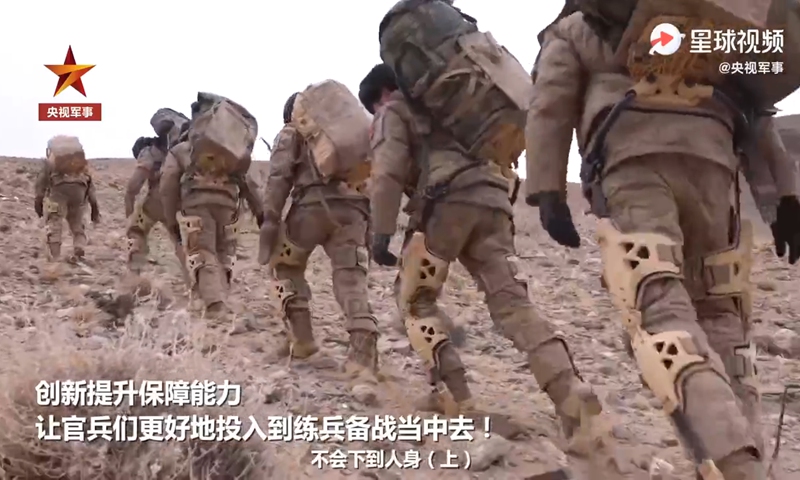Update: PLA border troops in Tibet receive exoskeleton suits: report
By GT staff reporters Source: Global Times Published: 2020/12/10 20:31:00 Last Updated: 2020/12/11 21:10:04

Chinese People's Liberation Army border defense troops wear exoskeleton suits in a supply delivery mission in Ngari, Southwest China's Tibet Autonomous Region in 2020. Photo: Screenshot from China Central Television
Chinese People's Liberation Army (PLA) border defense troops in Ngari, Southwest China's Tibet Autonomous Region, recently received a type of exoskeleton suit that enables them to conduct tasks in harsh, high altitude environments more efficiently, state media reported.
This kind of exoskeleton suit is particularly effective in missions such as supply delivery, patrol and sentry duty, analysts said on Thursday.
PLA border troops stationed in Ngari, which is more than 5,000 meters above sea level, have started using the exoskeleton suit, which allows them to carry supplies that weigh about as much as an adult, while avoiding the risk of waist or leg injuries, China Central Television (CCTV) reported on Wednesday.
During a recent supply delivery mission, several soldiers attached to the PLA Xinjiang Military Command carried food and water, with each person carrying about 20 kilograms of these supplies in backpacks, according to the CCTV report.
The weight of the backpacks is transferred to the frames of the exoskeleton suits, instead of the soldiers' legs, a soldier told CCTV.
The CCTV report did not give the designation or further technical details about the suit. Judging from the footage in the report, the equipment is likely a lightweight, non-powered exoskeleton suit.
This kind of suit is particularly helpful at high altitudes, a military expert told the Global Times on Thursday on condition of anonymity.
Due to the lack of oxygen, goods feel much heavier than their actual weight, and human stamina also declines as the elevation rises, the expert said, noting that an exoskeleton suit can help its wearer save energy and protect their joints.
In border defense operations, the suits can support troops in missions like supply delivery, patrol and sentry duty, the expert said.
It will give Chinese troops a significant physical advantage in the border regions, when troops on the other side of the line do not use such equipment and suffer from fatigue, analysts said.
No. 208 Research Institute of China Ordnance Industries has delivered the first batch of exoskeleton suits to PLA border defense forces in November, and a contract for a second batch was awarded in December due to positive feedback from the troops, the institute said on Friday in a statement.
It is not known if the suits by the No. 208 Institute are the ones reported by CCTV.
The PLA had been previously testing exoskeleton suits, as it held a competition called "Super Warriors" in 2019, in which more than 50 types of exoskeleton prototypes made by 25 developers from all over the country competed in seven areas including lightweight mobilization, heavy-load marching, supply transport and munitions loading, the PLA Daily reported in November 2019.
All kinds of exoskeleton suits, whether powered or non-powered, rigid or flexible, and lower-body only or full-body, are emerging from laboratories
Posted in: MILITARY,CHINA FOCUS